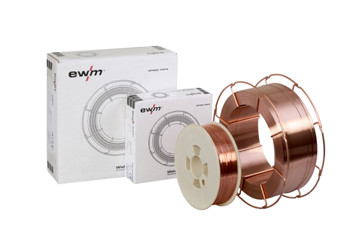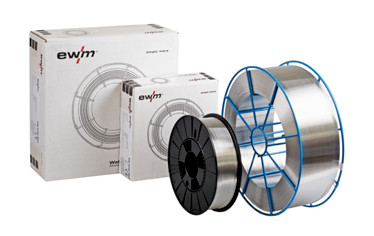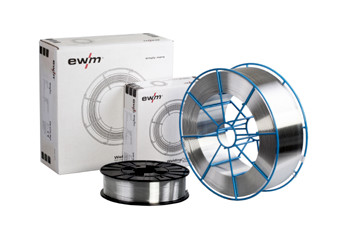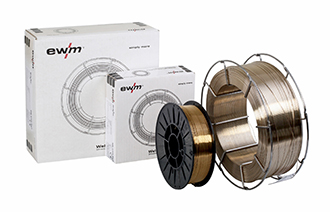Welding consumables, auxiliary and tool materials
- Wire electrode types
- Unalloyed and low-alloy steels
- High-alloy steels and nickel-based alloys
- Aluminium and aluminium alloys
- Other materials
Wire electrode types
Wire electrodes for the MIG/MAG welding of unalloyed steels and fine-grained steels are standardised in DIN EN 440. The standard classifies 11 types of welding wires according to their chemical analysis. However, it also contains types of welding wire that are only common in other European countries. For unalloyed steels in Germany, only G2Si1, G3Si1 and G4Si1 grades are used to any significant extent. These contain increasing amounts of silicon and manganese in the order mentioned above, on average from 0.65 to 0.9 % silicon and from 1.10 to 1.75 % manganese. For fine-grained steels, grades G4Mo and G3Ni1 and G3Ni2 are also used. Flux cored wire electrodes for welding these steels are contained in DIN EN 758. Depending on the composition of the filler, a distinction is made between rutile types, basic types and metal powder types. In addition to flux cored wire for MIG/MAG welding, DIN EN 758 also standardises self-shielded flux cored wires, which are welded without any additional added shielding gas. They are often used for weld cladding. Wire electrodes for welding heat-resistant steels are standardised in DIN EN 12070, flux cord wire electrodes for these steels are standardised in DIN EN 12071. The wire electrodes range from the only molybdenum alloy version to the wires with 1, 2.5, 5 and 9 % chromium up to the wire electrode with 12 % chromium. Molybdenum, vanadium and tungsten are in other alloy elements. There are flux cored wire electrodes up to 5 % chromium. Wire electrodes for welding stainless and heat-resisting steels are standardised in DIN EN 12072; flux cord wire electrodes for these steels are standardised in DIN EN 12073. The standards classify additives for martensitic / ferritic chromium steels, ferritic / austenitic steels and fully austenitic high corrosion-resistant steels, as well as special types and heat-resistant types.
Materials for MIG/MAG welding
Unalloyed and low-alloy steels
 Unalloyed and low-alloy steels are welded using mixed gases M1, M2, M3 or using pure carbon dioxide. However, on account of the lower spatter formation, especially in the upper power range, mixed gases predominate in Germany. These steels are generally easy to weld using MAG process. High-carbon grades such as E 360, with approx. 0.45 % C are an exception to this rule. Due to the high fusion penetration of the process, the weld metal absorbs a relatively larger amount of carbon via dilution, creating a higher risk of hot cracks. This can be remedied by all measures that reduce the fusion penetration and therefore also the dilution. This includes low current intensities and welding on forward travelling weld metals – Caution: Risk of fusion faults. Pores form in unalloyed and low-alloy steels primarily due to nitrogen. This can be due to dilution when welding steels with a high nitrogen content, e.g. nitriding steels. Nitrogen, however, is normally absorbed from the air as a result of an incomplete shielding gas bell. Safe protection from this is guaranteed if the correct quantity of shielding gas has been set and turbulence in the shielding gas flow, e.g. through spattering in the shielding gas nozzle or instabilities in the process, is avoided. Carbon dioxide as a shielding gas is less sensitive to this type of pore formation than mixed gases. In the case of mixed gases, the sensitivity is reduced as the CO2 content increases.
Unalloyed and low-alloy steels are welded using mixed gases M1, M2, M3 or using pure carbon dioxide. However, on account of the lower spatter formation, especially in the upper power range, mixed gases predominate in Germany. These steels are generally easy to weld using MAG process. High-carbon grades such as E 360, with approx. 0.45 % C are an exception to this rule. Due to the high fusion penetration of the process, the weld metal absorbs a relatively larger amount of carbon via dilution, creating a higher risk of hot cracks. This can be remedied by all measures that reduce the fusion penetration and therefore also the dilution. This includes low current intensities and welding on forward travelling weld metals – Caution: Risk of fusion faults. Pores form in unalloyed and low-alloy steels primarily due to nitrogen. This can be due to dilution when welding steels with a high nitrogen content, e.g. nitriding steels. Nitrogen, however, is normally absorbed from the air as a result of an incomplete shielding gas bell. Safe protection from this is guaranteed if the correct quantity of shielding gas has been set and turbulence in the shielding gas flow, e.g. through spattering in the shielding gas nozzle or instabilities in the process, is avoided. Carbon dioxide as a shielding gas is less sensitive to this type of pore formation than mixed gases. In the case of mixed gases, the sensitivity is reduced as the CO2 content increases.
High-alloy steels and nickel-based alloys
 In principle, this material group can also be welded well using the MIG/MAG process. The shielding gases used for high-alloy steels are argon / oxygen mixtures with 1-5 % oxygen (M1.1) or argon with CO2 contents of up to 2.5 % (M1.2). A significant disadvantage when welding corrosion-resistant steels is the oxide skins, which remain on and next to the seam after welding. These skins need to be removed by brushing, etching or blasting before the component is used in operation, as they impair the corrosion-resistance of the metal. The amount of cleaning work MAG-welded seams demands is greater than with MMA welding, where the slag covering prevents oxygen from penetrating the weld surface at higher temperatures. Part of the economic advantages of partly mechanised welding can therefore be lost owing to the amount of clean-up work required. Mixed gases containing CO2 are more favourable in this respect than those containing O2. As a result, they are being increasingly used. The carbon dioxide content in shielding gas must not be too high, however, as the gas decomposing in the arc causes the weld metal to carbonise, which in turn reduces the corrosion resistance. The permissible CO2 content is therefore limited to max. 5 %. When welding corrosion-resistant steels, any overheating must be avoided, as it could result in embrittlement and reduces the corrosion-resistance owing to chromium carbide deposits. The heat input therefore needs to be checked and it may be necessary to allow the workpiece to cool down by including cooling breaks during work. With materials in the full austenitic steels groups, “cold” welding is also an option to avoid heat cracks. As austenitic steels do not become brittle under the influence of hydrogen, a few percent of hydrogen can also be added to the argon to increase performance (increase the welding speed). However, the H2 content should not be more than 7 % owing to the risk of pore formation. Duplex steels with a two-phase structure of austenite and ferrite, however, have more of a tendency towards hydrogen induced cracking. Nickel-based alloys are generally MIG-welded using argon. In the case of pure nickel and some alloys, low levels of hydrogen additives can reduce the surface tension and thus improve the seam formation.
In principle, this material group can also be welded well using the MIG/MAG process. The shielding gases used for high-alloy steels are argon / oxygen mixtures with 1-5 % oxygen (M1.1) or argon with CO2 contents of up to 2.5 % (M1.2). A significant disadvantage when welding corrosion-resistant steels is the oxide skins, which remain on and next to the seam after welding. These skins need to be removed by brushing, etching or blasting before the component is used in operation, as they impair the corrosion-resistance of the metal. The amount of cleaning work MAG-welded seams demands is greater than with MMA welding, where the slag covering prevents oxygen from penetrating the weld surface at higher temperatures. Part of the economic advantages of partly mechanised welding can therefore be lost owing to the amount of clean-up work required. Mixed gases containing CO2 are more favourable in this respect than those containing O2. As a result, they are being increasingly used. The carbon dioxide content in shielding gas must not be too high, however, as the gas decomposing in the arc causes the weld metal to carbonise, which in turn reduces the corrosion resistance. The permissible CO2 content is therefore limited to max. 5 %. When welding corrosion-resistant steels, any overheating must be avoided, as it could result in embrittlement and reduces the corrosion-resistance owing to chromium carbide deposits. The heat input therefore needs to be checked and it may be necessary to allow the workpiece to cool down by including cooling breaks during work. With materials in the full austenitic steels groups, “cold” welding is also an option to avoid heat cracks. As austenitic steels do not become brittle under the influence of hydrogen, a few percent of hydrogen can also be added to the argon to increase performance (increase the welding speed). However, the H2 content should not be more than 7 % owing to the risk of pore formation. Duplex steels with a two-phase structure of austenite and ferrite, however, have more of a tendency towards hydrogen induced cracking. Nickel-based alloys are generally MIG-welded using argon. In the case of pure nickel and some alloys, low levels of hydrogen additives can reduce the surface tension and thus improve the seam formation.
Aluminium and aluminium alloys
 Aluminium materials are usually MIG-welded. Argon is generally used as the shielding gas. Since aluminium has a high level of thermal conductivity, the addition of helium is especially useful here. As previously mentioned, helium improves the thermal conductivity and the thermal retention of the shielding gas atmosphere. This gives a deeper and wider fusion penetration. Where this deeper weld penetration is not needed, e.g. when welding thinner sheet metal, welding can be performed more quickly with the same fusion penetration form. Thicker sections of aluminium must be pre-heated owing to the high thermal conductivity of the material. This not only ensures sufficient fusion penetration but also reduces the tendency to form pores because the weld metal has more time to release the gas during the embrittling process. When using shielding gases containing helium – standard content levels are 25 or 50 % - the preheating can be reduced or may not be necessary at all in the case of smaller wall thicknesses. This partially compensates for the higher price of gases containing helium. Difficulties in eliminating the high-melting oxide skin on the bath do not exist in MIG welding as the plus pole is on the electrode (cathodic cleaning). Nevertheless, it is advisable to remove the oxide skins immediately prior to welding by scraping or brushing, as they are hygroscopic and therefore carry hydrogen into the weld metal. Hydrogen is the sole cause of pore formation when welding aluminium materials. In its molten state, aluminium has a relatively high level of solubility for hydrogen, in its solid state, however, this gas is hardly soluble in the metal. If no pores are to be formed, then any hydrogen absorbed during welding must therefore leave the weld metal before the embrittling process. This is not always possible, especially with thicker cross-sections. In the case of larger wall thicknesses, entirely pore-free seams cannot be achieved with aluminium materials. The beneficial effect of preheating has previously been mentioned. With Si contents of around 1 % or Mg contents of around 2 %, AlMg and AlSi alloys tend towards heat cracks during welding. Avoid this alloy range when selecting the welding consumable. Wire electrodes with an alloy content one degree higher are usually better than electrodes of exactly the same type.
Aluminium materials are usually MIG-welded. Argon is generally used as the shielding gas. Since aluminium has a high level of thermal conductivity, the addition of helium is especially useful here. As previously mentioned, helium improves the thermal conductivity and the thermal retention of the shielding gas atmosphere. This gives a deeper and wider fusion penetration. Where this deeper weld penetration is not needed, e.g. when welding thinner sheet metal, welding can be performed more quickly with the same fusion penetration form. Thicker sections of aluminium must be pre-heated owing to the high thermal conductivity of the material. This not only ensures sufficient fusion penetration but also reduces the tendency to form pores because the weld metal has more time to release the gas during the embrittling process. When using shielding gases containing helium – standard content levels are 25 or 50 % - the preheating can be reduced or may not be necessary at all in the case of smaller wall thicknesses. This partially compensates for the higher price of gases containing helium. Difficulties in eliminating the high-melting oxide skin on the bath do not exist in MIG welding as the plus pole is on the electrode (cathodic cleaning). Nevertheless, it is advisable to remove the oxide skins immediately prior to welding by scraping or brushing, as they are hygroscopic and therefore carry hydrogen into the weld metal. Hydrogen is the sole cause of pore formation when welding aluminium materials. In its molten state, aluminium has a relatively high level of solubility for hydrogen, in its solid state, however, this gas is hardly soluble in the metal. If no pores are to be formed, then any hydrogen absorbed during welding must therefore leave the weld metal before the embrittling process. This is not always possible, especially with thicker cross-sections. In the case of larger wall thicknesses, entirely pore-free seams cannot be achieved with aluminium materials. The beneficial effect of preheating has previously been mentioned. With Si contents of around 1 % or Mg contents of around 2 %, AlMg and AlSi alloys tend towards heat cracks during welding. Avoid this alloy range when selecting the welding consumable. Wire electrodes with an alloy content one degree higher are usually better than electrodes of exactly the same type.
Other materials
Besides the previously mentioned materials, only copper and copper alloys are MIG-welded to a significant extent. Owing to its high thermal conductivity, pure copper needs a relatively high level of pre-heating in order to avoid lack of fusion. The weld metal for bronze wires, e.g. those made from aluminium bronze or tin bronze, has good sliding properties. It is therefore used for surfacing sliding surfaces. In such welds on ferrous materials, the fusion penetration must be kept low by taking appropriate measures because iron has a low level of solubility in copper. It is included in the weld metal in the form of small balls and reduces the usage properties. MIG brazing has similar conditions. For example, this process is used to connect galvanised panels in automobile construction. Silicium or tin bronze wire electrodes are used as consumables. The zinc vaporisation level is reduced on account of the low melting point of these bronzes. Fewer pores are created and the protection provided by the zinc coating is retained right up to near the seam and on the back of the panels. Here, too, no fusion penetration should occur in the steel material if possible, but the connection should be made solely via diffusion and adhesion forces, as in brazing. This is achieved by adjusting the welding parameters and using a special torch position so that the arc only burns on the molten weld pool.
